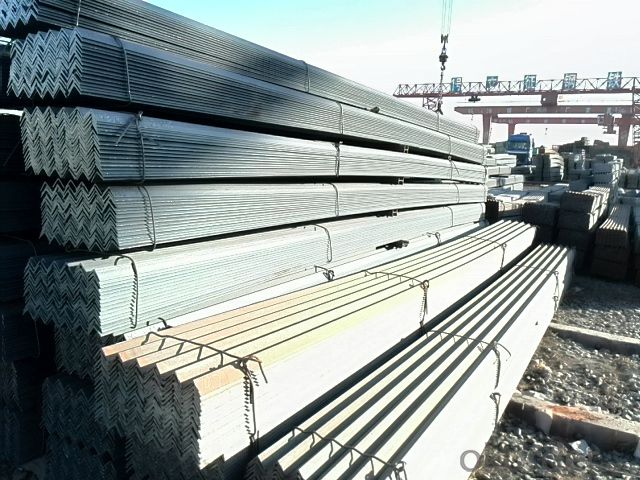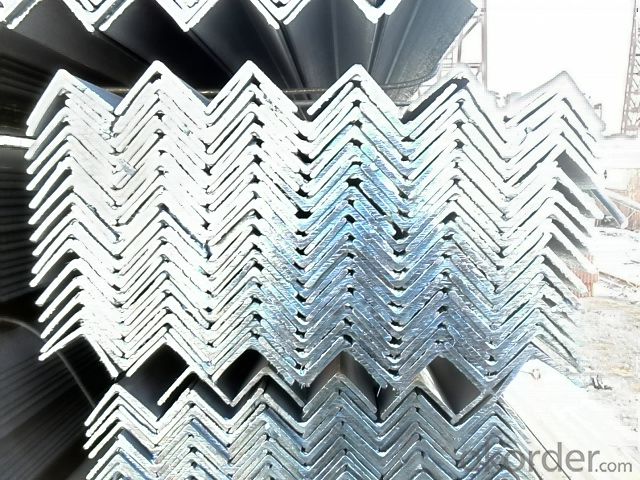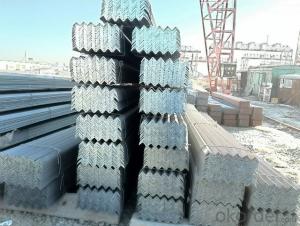Steel Angle Bars Hot Rolled Source from China
- Loading Port:
- Tianjin
- Payment Terms:
- TT OR LC
- Min Order Qty:
- 25 m.t
- Supply Capability:
- 10000 m.t/month
OKorder Service Pledge
OKorder Financial Service
You Might Also Like
Item specifice
Okorder.com is a professional materials & equipment supplier & manufacturer, offers integrated one-stop services including real-time quoting and online cargo tracking. We are funded by CNBM Group, a Fortune 500 enterprise and the largest materials & equipment firm in China.
Product Applications:
According to the needs of different structures, Angle can compose to different force support component, and also can be the connections between components. It is widely used in various building structures and engineering structures such as roof beams, bridges, transmission towers, hoisting machinery and transport machinery, ships, industrial furnaces, reaction tower, container frame and warehouse etc.
Product Advantages:
OKorder's Steel Angles are durable, strong, and resist corrosion.
Main Product Features:
· Premium quality
· Prompt delivery & seaworthy packing (30-45 days after receiving deposit)
· Corrosion resistance
· Can be recycled and reused
· Mill test certification
· Professional Service
· Competitive pricing
Product Specifications:
1. Invoicing on theoretical weight or actual weight as customer request
2. Length: 6m, 9m, 12m as following table
3. Sizes

Sizes: 25mm-250mm | ||
a*t | ||
25*2.5-4.0 | 70*6.0-9.0 | 130*9.0-15 |
30*2.5-6.6 | 75*6.0-9.0 | 140*10-14 |
36*3.0-5.0 | 80*5.0-10 | 150*10-20 |
38*2.3-6.0 | 90*7.0-10 | 160*10-16 |
40*3.0-5.0 | 100*6.0-12 | 175*12-15 |
45*4.0-6.0 | 110*8.0-10 | 180*12-18 |
50*4.0-6.0 | 120*6.0-15 | 200*14-25 |
60*4.0-8.0 | 125*8.0-14 | 250*25 |
4.Material details:
Alloy No | Grade | Element (%) | |||||
C | Mn | S | P | Si | |||
Q235 | B | 0.12—0.20 | 0.3—0.7 | ≤0.045 | ≤0.045 | ≤0.3 | |
Alloy No | Grade | Yielding strength point( Mpa) | |||||
Thickness (mm) | |||||||
≤16 | >16--40 | >40--60 | >60--100 | ||||
≥ | |||||||
Q235 | B | 235 | 225 | 215 | 205 | ||
Alloy No | Grade | Tensile strength (Mpa) | Elongation after fracture (%) | ||||
Thickness (mm) | |||||||
≤16 | >16--40 | >40--60 | >60--100 | ||||
≥ | |||||||
Q235 | B | 375--500 | 26 | 25 | 24 | 23 | |
FAQ:
Q1.What's your payment terms ?
A1:1)100% irrevocable L/C at sight.
2)30% T/T prepaid and the balance against the copy of B/L.
3)30% T/T prepaid and the balance against L/C
4)100% irrevocable L/C at 90/120/180 sight.
Q2: How do we guarantee the quality of our products?
A2: We have established an advanced quality management system which conducts strict quality tests at every step, from raw materials to the final product. At the same time, we provide extensive follow-up service assurances as required.
Q3: Can fit in the containers of 20fts for 6M long ?
A3: Yes, we can put them into the containers in the form sideling, in this way we can save the buyer much ocean freight.
Images:


- Q:How do you cut steel angles?
- Steel angles can be cut using various methods such as using a metal-cutting saw, an angle grinder with a cutting disc, or a plasma cutter. It is important to ensure proper safety precautions, use appropriate tools, and follow the manufacturer's instructions for the specific cutting method being used.
- Q:How do you prevent welding distortion in steel angles?
- To prevent distortion in steel angles during welding, there are several strategies that can be implemented: 1. Ensure proper welding technique by correctly setting welding parameters, such as voltage, current, and travel speed, to control heat input. This prevents excessive heating of the steel angles, which can cause distortion. 2. Prepare the steel angles before welding by cleaning surfaces to remove dirt, oil, or rust. Also, bevel the edges of the angles to create a V-groove joint. This allows for better penetration and reduces the risk of distortion. 3. Temporarily hold the steel angles in place using tack welds before final welding. Strategically place these tack welds to evenly distribute stresses during welding and minimize distortion. 4. Determine the most suitable weld sequence for the specific joint configuration. Start welding from the center and progress outwards, alternating sides to balance heat input. This helps avoid localized overheating and subsequent distortion. 5. Use fixtures or clamps to hold the steel angles in place during welding. This ensures they remain in the correct position and minimizes distortion caused by movement or displacement during welding. 6. Consider preheating the steel angles before welding to reduce the risk of distortion. Controlled post-weld heat treatment may also be applied to relieve residual stresses and minimize distortion. 7. Adjust the welding sequence if the steel angles are part of a larger assembly. This involves welding in a specific order to balance shrinkage forces and reduce overall distortion of the assembly. By implementing these measures, welding distortion in steel angles can be effectively prevented, resulting in high-quality welds and ensuring the structural integrity of the fabricated components.
- Q:Can steel angles be used in sports facilities or stadium constructions?
- Yes, steel angles can be used in sports facilities or stadium constructions. Steel angles are commonly used in the construction industry due to their versatility, strength, and durability. In sports facilities or stadium constructions, steel angles can be used for various purposes. One of the key applications of steel angles in sports facilities and stadium constructions is in the framework and support structures. Steel angles can be used to create the framework for seating areas, walkways, stairs, and entrances. They provide excellent structural support and can withstand heavy loads, making them ideal for accommodating large crowds and ensuring the safety of the spectators. Steel angles can also be used in the construction of various sports equipment. For instance, they can be used to create the framework for basketball hoops, soccer goals, or volleyball nets, ensuring stability and durability during intense gameplay. Additionally, steel angles can be utilized for the construction of fencing or barriers around sports fields or tracks, providing safety and security for both players and spectators. Furthermore, steel angles are often used in the installation of lighting systems in sports facilities and stadiums. They can be used to mount floodlights, scoreboards, or other equipment necessary for proper illumination during games or events. In summary, steel angles are an essential component in sports facility and stadium constructions. Their strength, versatility, and durability make them a reliable choice for various applications, including framework and support structures, sports equipment, and lighting systems.
- Q:How do you prevent and address corrosion in steel angles?
- Corrosion prevention and addressing in steel angles can be achieved through several effective measures. Here are some steps you can take: 1. Proper surface preparation: Thoroughly clean the steel angles before applying any protective measures. Remove any dirt, grease, or other contaminants using a suitable solvent or detergent. 2. Protective coatings: Applying a high-quality coating is crucial to prevent corrosion. Options include paints, primers, and specialized corrosion-resistant coatings designed for steel. Ensure the coating is compatible with the environmental conditions the steel angles will be exposed to. 3. Galvanization: Galvanizing steel angles can provide excellent corrosion resistance. This involves applying a layer of zinc to the surface, creating a barrier between the steel and the corrosive elements in the environment. 4. Regular inspection and maintenance: Periodically inspect the steel angles for signs of corrosion, such as rust or pitting. Address any corrosion issues immediately to prevent further damage. This may involve removing the damaged coating, treating the corroded area, and reapplying a protective coating. 5. Cathodic protection: For critical applications or aggressive environments, consider implementing cathodic protection. This technique involves connecting sacrificial anodes or installing impressed current systems to protect the steel angles from corrosion by creating an electrochemical reaction. 6. Environmental control: Limiting exposure to moisture, humidity, and corrosive chemicals can significantly reduce the risk of corrosion. Proper ventilation, dehumidification, and avoiding direct contact with corrosive substances are essential preventive measures. 7. Routine cleaning: Regularly clean the steel angles to remove any accumulated dirt, debris, or corrosive substances, as they can accelerate corrosion. Use gentle cleaning methods and avoid abrasive materials that can damage the protective coating. Remember, preventing and addressing corrosion in steel angles requires a proactive approach. By implementing these measures, you can extend the lifespan of the steel angles and maintain their structural integrity.
- Q:Are steel angles available in pre-galvanized form?
- Yes, steel angles are available in pre-galvanized form.
- Q:What are the common applications of steel angles in architecture?
- Due to their versatility and strength, steel angles are extensively utilized in architecture for various purposes. Here are some common applications of steel angles in architecture: 1. Building construction often relies on steel angles as structural support elements. By welding or bolting them together, a robust framework is formed, providing the necessary strength and stability to the structure. 2. Steel angles are commonly employed in framing applications, such as constructing door and window frames, as well as roof trusses. They ensure rigidity and support, ultimately contributing to the stability and longevity of the overall structure. 3. Reinforcing concrete structures is another popular use of steel angles. Embedding them into concrete walls, columns, and beams enhances their load-bearing capacity and resistance to deformation. 4. Staircases and handrails are frequently constructed using steel angles. These angles form a sturdy framework that guarantees the safety and stability of these architectural elements. 5. Steel angles are also employed for architectural detailing purposes. They can be utilized to create decorative elements like cornices, brackets, and ornamental features, which enhance the aesthetic appeal of the building. 6. In industrial settings, such as factories and warehouses, steel angles are utilized to create robust platforms, mezzanines, and equipment supports. In summary, steel angles are a versatile and reliable material that offers numerous benefits for architectural applications. Their strength, durability, and flexibility make them an ideal choice for a wide range of architectural structures and features.
- Q:Can steel angles be used in agricultural applications?
- Yes, steel angles can be used in agricultural applications. They are commonly used in the construction of buildings, fences, and equipment in the agricultural industry due to their strength, durability, and versatility.
- Q:Can steel angles be used in the construction of bridges?
- Steel angles have a wide range of applications in the construction of bridges. They are frequently utilized due to their versatility and ability to enhance the strength and support of bridge structures. Specifically, they are commonly employed in constructing bridge decks, railings, and supports. The high strength-to-weight ratio of steel angles makes them especially suitable for bridge construction. They can withstand heavy loads and contribute to the stability of the bridge structure. Moreover, their durability and resistance to corrosion are vital attributes for bridges exposed to diverse environmental conditions. In bridge construction, steel angles are often combined with other steel components, such as beams and columns, to create a robust and dependable structure. They are frequently employed as bracing elements to reinforce the overall stability of the bridge. Additionally, steel angles can serve as connection elements, securely joining different parts of the bridge. In summary, steel angles play a critical role in bridge construction by providing strength, durability, and stability. Their versatility and reliability make them a preferred choice for engineers and designers when constructing bridges of various sizes and types.
- Q:Are steel angles suitable for architectural applications?
- Indeed, architectural applications are well-suited for steel angles. In construction and architectural projects, steel angles are frequently employed due to their adaptability, robustness, and visual allure. They serve a multitude of purposes, including the formation of structural frames, supports, connections, and even decorative elements. Architects are provided with a wide range of options when it comes to steel angles, as they are available in various sizes, thicknesses, and finishes, enabling the selection of the most appropriate choice in accordance with specific design requirements. Moreover, steel angles can be effortlessly welded, drilled, and manipulated to accommodate diverse angles and shapes, thus rendering them a versatile and economical alternative for architectural applications.
- Q:Are steel angles cost-effective?
- Indeed, steel angles prove to be economical. Their versatility and durability lead to their extensive use across different industries and construction endeavors. The simplicity of their manufacturing process, along with their widespread availability and impressive strength-to-weight ratios, contribute to their high cost-effectiveness. Furthermore, the extended lifespan of steel angles reduces the necessity for frequent replacements or repairs, ultimately minimizing maintenance expenses in the long term. Additionally, the recyclability of steel angles aligns with environmental consciousness and sustainability. All in all, the affordability of steel angles establishes them as a favored option for both structural and architectural purposes.
1. Manufacturer Overview |
|
|---|---|
| Location | |
| Year Established | |
| Annual Output Value | |
| Main Markets | |
| Company Certifications | |
2. Manufacturer Certificates |
|
|---|---|
| a) Certification Name | |
| Range | |
| Reference | |
| Validity Period | |
3. Manufacturer Capability |
|
|---|---|
| a)Trade Capacity | |
| Nearest Port | |
| Export Percentage | |
| No.of Employees in Trade Department | |
| Language Spoken: | |
| b)Factory Information | |
| Factory Size: | |
| No. of Production Lines | |
| Contract Manufacturing | |
| Product Price Range | |
Send your message to us
Steel Angle Bars Hot Rolled Source from China
- Loading Port:
- Tianjin
- Payment Terms:
- TT OR LC
- Min Order Qty:
- 25 m.t
- Supply Capability:
- 10000 m.t/month
OKorder Service Pledge
OKorder Financial Service
Similar products
New products
Hot products
Related keywords




























